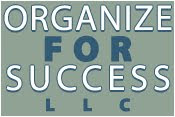Now that we are just a few days away from 2015, by following the assignments in this series, you’ve laid an excellent foundation for success in the new year; however, in order to achieve your optimum success, it is important to establish a work environment that’s yet another tool in your productivity toolbox. If your paper and electronic files are unorganized and filled with unnecessary contents, they can be overwhelming and unhelpful. This week is an ideal time to “get clear for the new year” by proactively addressing your filing as well as where items are kept in your workspace.
First, take time to edit the contents of your workspace. When files are overstuffed with outdated information, it is difficult to locate what you need when you need it; therefore, it is vital to address your files before the new year, clearing out what no longer needs to be there.
- Will the documents be relevant to work in the coming year? If you’ve completed the related project or the file contains last year’s receipts, move the content into storage with your archived files, rather than keeping it with your active files.
- Do you need this piece of paper? What’s the worst that can happen if you throw it away?
- Is the info on file somewhere else or easily accessible online?
If any file's contents are no longer (1) accurate, (2) applicable, (3) useful or (4) bringing you joy, consider getting rid of those contents. Can the discarded papers be recycled or do they need to be shredded? Further, if you are keeping something that would be easy to find again online, is it something you will reference frequently enough to justify the space it is taking to retain? Consider keeping only items that would be difficult to relocate or recreate.
Likewise, as you are purging the accumulated excess from your paper and electronic files, evaluate whether you can resell or recycle any technology that is no longer being used. Those devices, cords and accessories are taking up valuable real estate in your workspace, which could be devoted to items actually being used instead. Still, if you do utilize all the technological tools in your space, are there any that can be consolidated so you retain functionality while lowering the number of devices maintained? Keep in mind efficient use of what space you have.
Then, address the onslaught of emails received daily. Unsubscribe from eNewsletters you are not reading, consider bundling subscriptions that you do read via The Swizzle or Unroll.me and create a system for diligently keeping up on reading.
Take time to verify everything in your workspace has a home as well as that each item is in its assigned home. When folks are looking to buy real estate, you often hear “location, location, location”, and I challenge you to consider your workspace in the same light as buying real estate where location really does matter. The space closest to where you will be working is considered the most valuable real estate location; therefore, that area should be filled with what items you use most frequently. Then, the placement of items moving out from there should be based on how often the item is needed, placing items used least frequently the farthest away.
- Make certain there is a 2014 tax folder to hold incoming documentation for the year ending; then, create a 2015 tax folder to be prepared for the upcoming new year’s tax records.
- Get accounting records up to snuff by writing off uncollectable accounts receivable; while accounts receivable write-offs are tax deductions this year, they become a bonus if collected in the new year.
- Make sure your tech tools are housed near where they will be used, that all accessories are still easily accessible and that any upgrades needed are completed before the new year starts.
- Simplify your office supplies and plan space for what new supplies will be needed in the new year.
By focusing on editing out what is no longer needed and, then, strategically assigning homes to what you will be keeping, your workspace will be a useful tool in your productivity toolbox, driving your optimum success.
ASSIGNMENT: Visit here to see a video related to this blog post; then, this week, take time to edit the contents of your workspace, removing contents that are no longer accurate, applicable, useful or bringing you joy, and verify everything to remain has a home as well as that each item is in its assigned home. What needs to be added or removed in order to simplify your work for better achieving your desired results? Be strategic, aligning the set-up in your workspace with the goals you’ve set, making sure the workspace is another tool in your productivity toolbox.
Leave a comment below about your ongoing system for editing the contents of your workspace. What tends to build up most quickly? How will you maintain the productive workspace that you’ll be creating this week?










